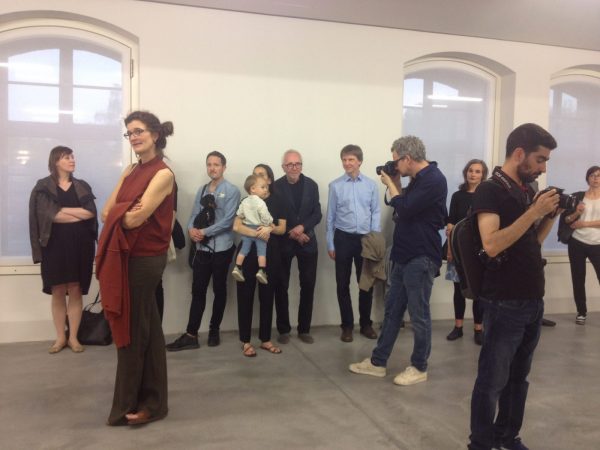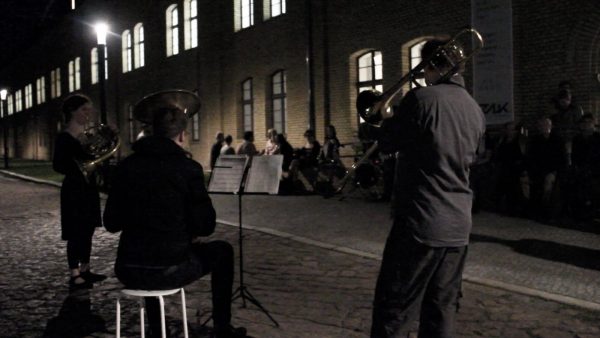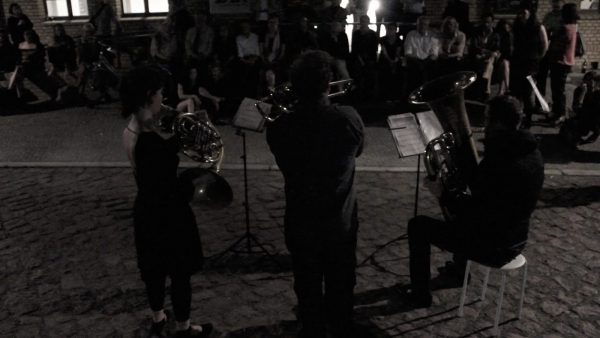20 April 2018. The program of ITINERANT INTERLUDE #80 drew primary inspiration from the extremely essential formal language of the works of Hartmut Böhm as well as from the expansive, rhythmic spaces in which they are installed. Indeed, as the works of AUSLEGUNGEN find counterpoint in the clarity and precision of the architecture of the Zitadelle’s Alte Kaserne, so too, the program of ITINERANT INTERLUDES offered an aural counterpoint to the works presented in the exhibition, namely, four different perspectives from the world of contemporary composition that reflect upon similar artistic concerns of reduction of material and form, systematic approach, and concentration.
Itinerant Sounds by Andrea Saba was commissioned especially for ITINERANT INTERLUDE #80 and composed as an homage to the works of Hartmut Böhm. Minimalist in its materials but maximal in resonance, the work consists of only one pitch “F” being passed from instrument to instrument. With subtle timbral transformations, Itinerant Sounds builds to create rich harmonic resonances in the space. The work was also written with the expansive galleries of the Zentrum für Aktuelle Kunst in mind: musicians are positioned far apart from one other at the corners of a large imaginary triangle and, in contrast to usual chamber music situations which rely on gestural and visual interaction between players, the absence of visual cues here requires musicians to rely on a particularly heightened sense of listening. Performers must react to sonic signals that come from afar, sounds which allow the musicians to orient themselves in space, similar to the way ambient resonances enable us to move in a space without light.
The score of Christoph Herndler’s vom Festen das Weiche (2007) is an example of how graphic notation – color and geometric form – may translate into a work of music. In this case, musicians are at liberty to choose a specific sequence of sounds, which are then color-coded and performed according to a grid of 25 rectangles of varying shapes: the work is an investigation of repetition and recombination. For Aaron Copland: DISTILLED… for itinerant interludes is a direct reference to Morton Feldman’s 1981 masterpiece For Aaron Copland for solo violin. The evening’s performance – prepared by Zinc & Copper for ITINERANT INTERLUDE #80 – is a distilled remix of the original work which famously moves among only 7 notes (the white keys of the piano). Here, Zinc & Copper performs the first 14 measures (= 14 notes) of Feldman’s piece in canon. Even in this verticalized form, the very essential character of the original rings through. Ellen Arkbro’s Three (2016) is a study in quiet harmony, composed of only a few of the simplest possible combinations of tones, in slowly shifting modulations: harmonic simplicity as a condition for stability of sound and harmonic awareness.
The interrelationships of form and freedom, rhythm and quiet, repetition and dynamics were explored by the members of Zinc & Copper throughout the evening, testing the resonances of the entire space, to ultimately spill out into the courtyard of the Zitadelle on a warm spring evening beneath a crescent moon.
Zinc & Copper (zinc + copper = brass) was founded by Robin Hayward in 2005, with Elena Kakaliagou and Hilary Jeffery making up the trio which serves as core for a variable ensemble of brass instruments. The group’s ongoing research into alternative performance techniques is distinguished for its pioneering approach which continues to expand upon the potential of the brass ensemble in the 21st century, opening up an enormous spectrum to reveal astonishing new sounds. The group records widely and performs at major venues and festivals of new music throughout the world.





























